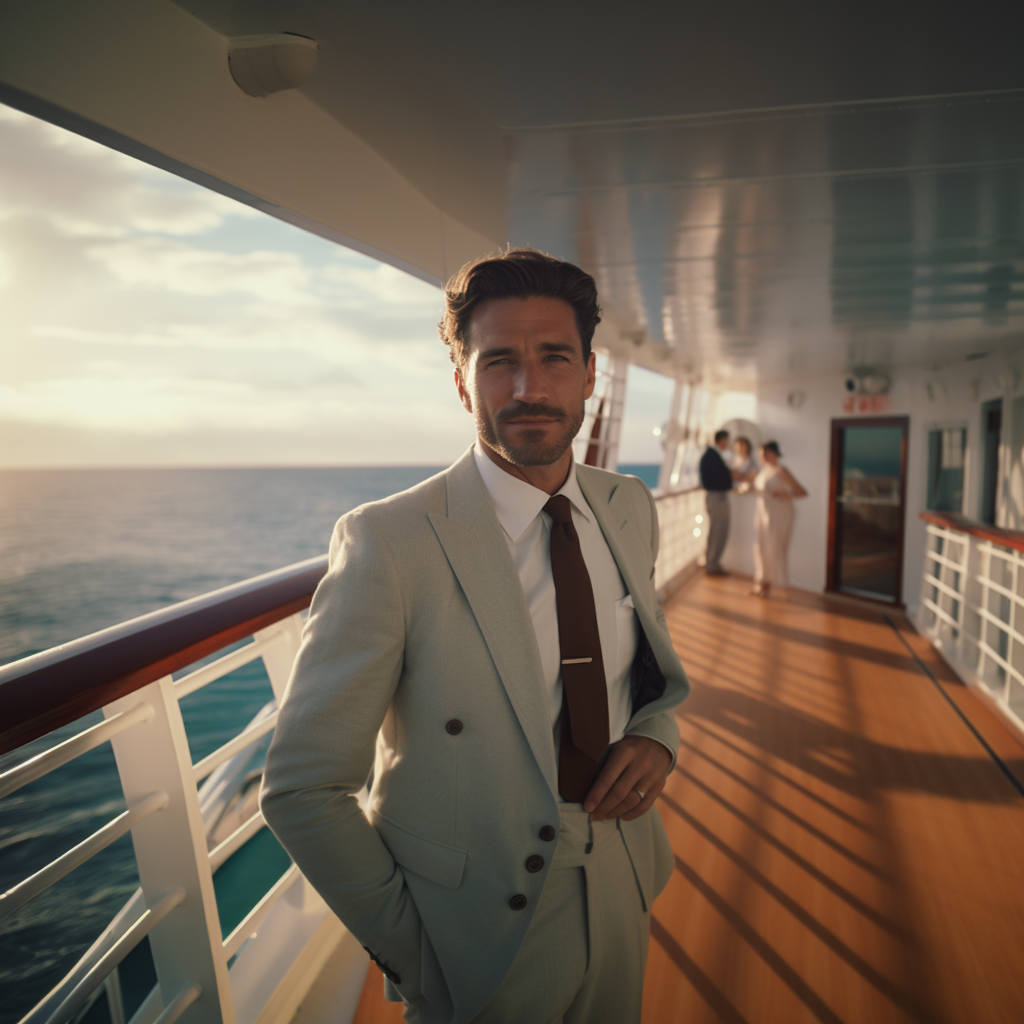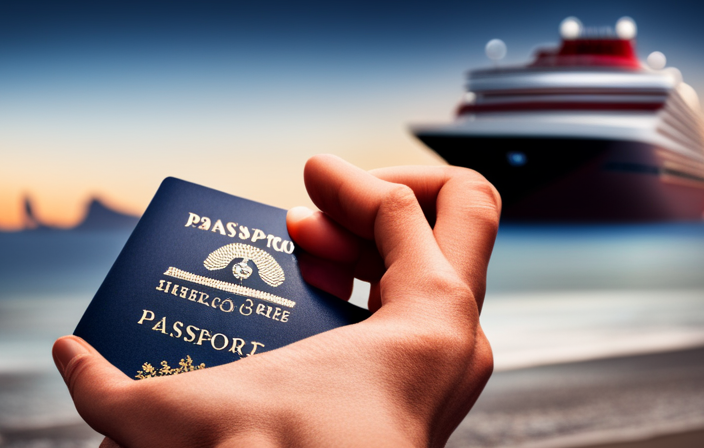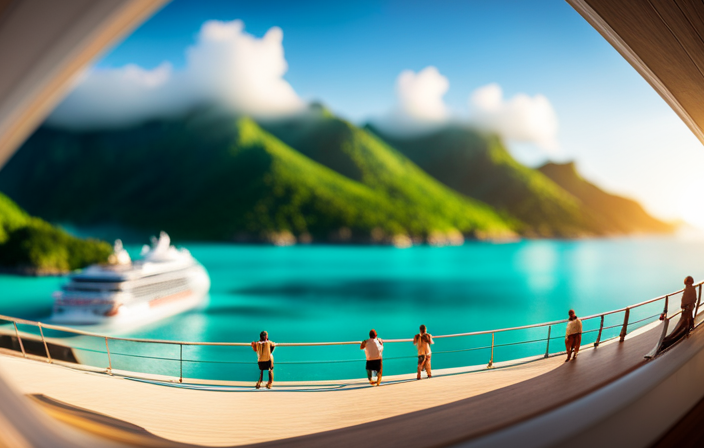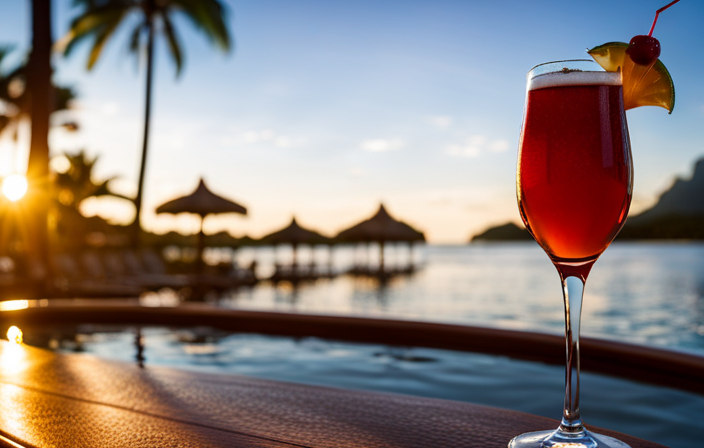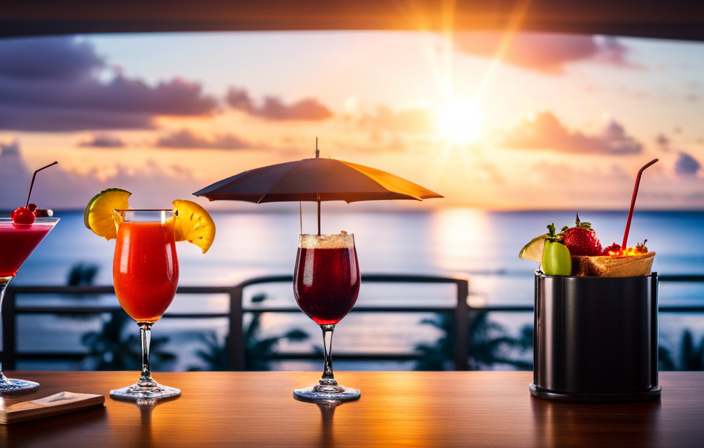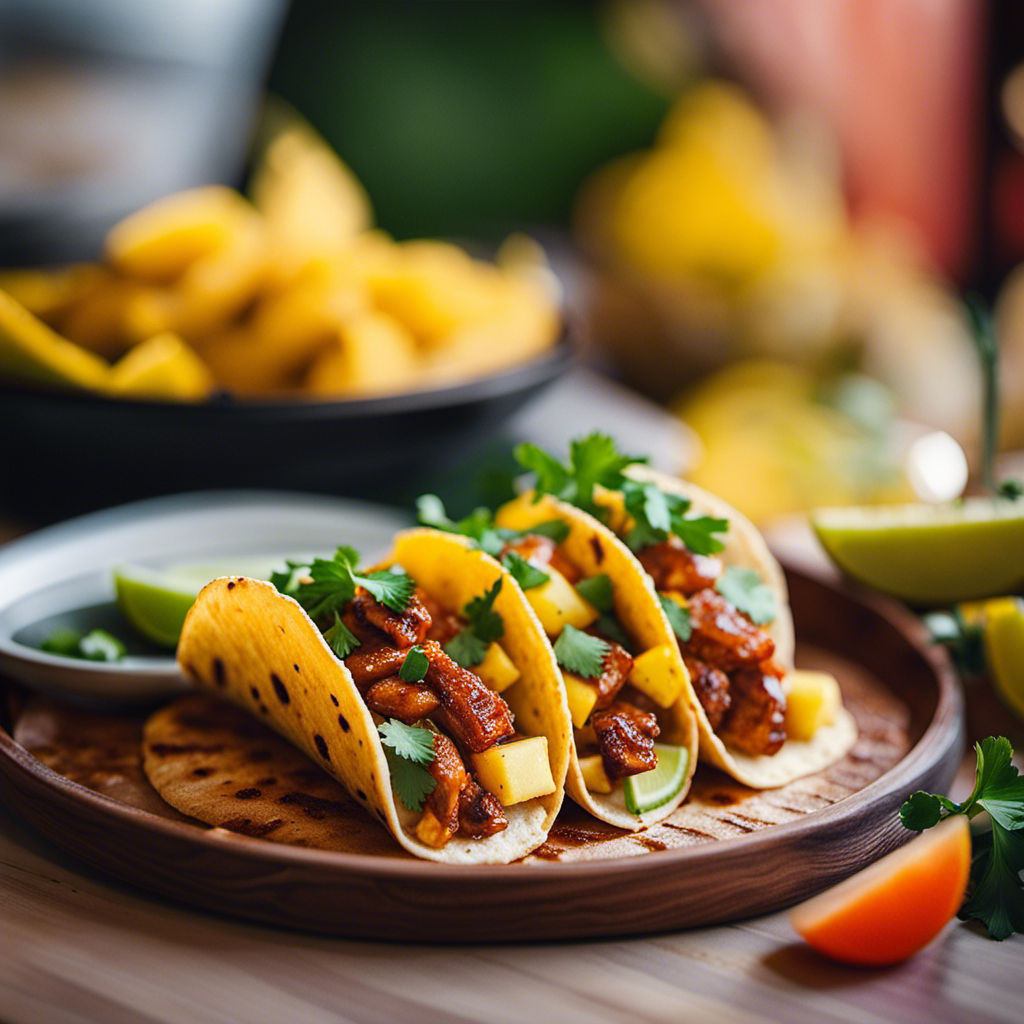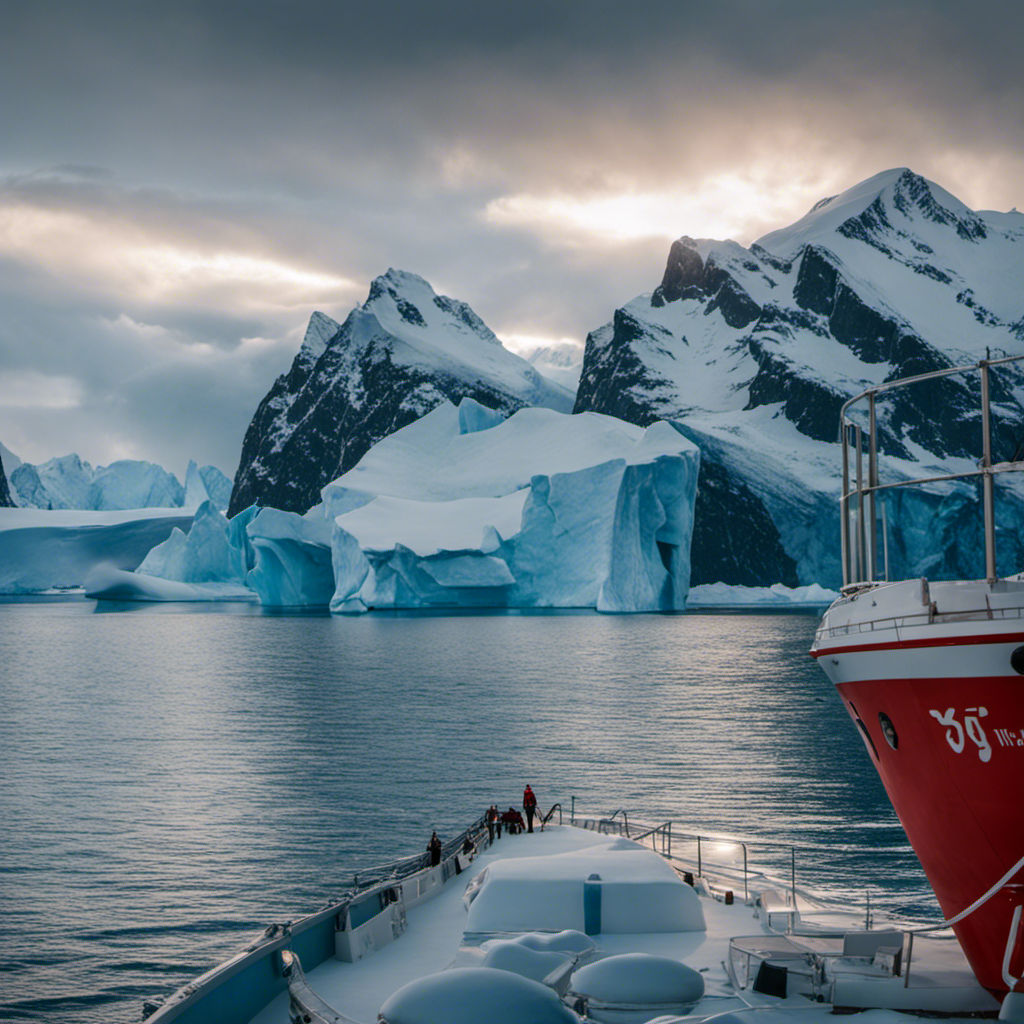Cruise FAQs
How Far Can A Cruise Ship Go Without Refueling
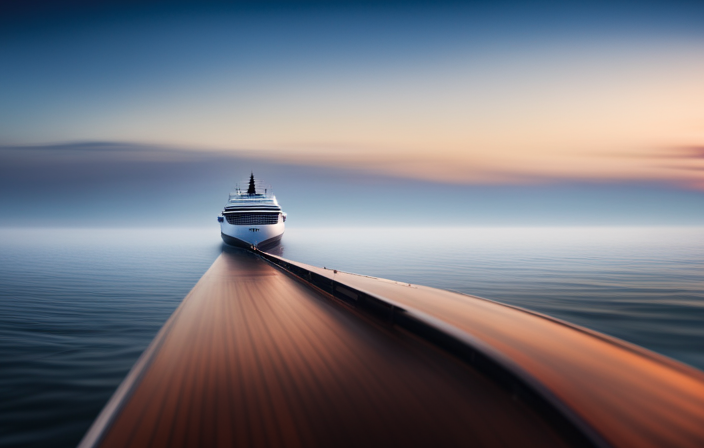
Have you ever thought about how far a cruise ship can go before it has to refuel? I’ve been fascinated by this question for quite some time. Being a passionate traveler and a dedicated fan of sea voyages, the incredible engineering feats that allow these massive vessels to glide through the oceans with ease have always captivated me.
In this article, we will explore the advancements in cruise ship fuel efficiency and delve into the science behind their fuel consumption. We’ll also examine the factors that affect a cruise ship’s fuel efficiency and discover some of the record-breaking distances traveled by these floating cities.
From the longest non-stop cruises to fueling strategies for long-distance voyages, we’ll uncover the secrets behind how cruise ships maximize their fuel efficiency. Join me as we dive into the world of cruise ship fuel efficiency and explore the possibilities for the future.
Key Takeaways
- Advancements in cruise ship fuel efficiency, such as the use of alternative fuels and innovative technologies, have enabled cruise ships to travel longer distances without frequent refueling stops.
- Factors like ship size, weight, design, and weather conditions can affect fuel consumption and, consequently, the ship’s range.
- Cruise lines are constantly exploring and implementing measures to improve fuel efficiency and reduce environmental impact, including the use of cleaner fuels, adoption of energy-efficient technologies, and collaboration with stakeholders.
- The future of cruise ship fuel efficiency holds promising possibilities, with continuous advancements in technology, research on alternative fuels and energy sources, and integration of renewable energy systems.
The Advancements in Cruise Ship Fuel Efficiency
You’ll be amazed at how much further a cruise ship can go without refueling thanks to the advancements in fuel efficiency.
Over the years, there have been significant advancements in cruise ship propulsion systems, leading to reduced fuel consumption and increased range.
One such advancement is the use of alternative fuels for cruise ships, such as liquefied natural gas (LNG) and hydrogen fuel cells. These fuels are cleaner burning and produce fewer emissions, making them a more environmentally friendly option.
Additionally, cruise ships now incorporate innovative technologies like advanced hull designs and energy-efficient engines, further improving fuel efficiency.
These advancements have enabled cruise ships to travel longer distances without the need for frequent refueling stops. Understanding the science behind cruise ship fuel consumption is crucial in maximizing efficiency and minimizing the environmental impact.
Understanding the Science Behind Cruise Ship Fuel Consumption
Cruise ships can travel impressive distances thanks to their efficient fuel consumption. Understanding fuel consumption patterns is crucial in maximizing the ship’s range.
Several factors affect fuel consumption, including the ship’s size, weight, and design. The type of engines used also plays a significant role. Modern cruise ships are equipped with advanced propulsion systems that are specifically designed for fuel efficiency. These systems optimize fuel consumption by adjusting the engine’s speed and power output based on the ship’s speed and load.
Additionally, the impact of alternative fuel sources, such as LNG (liquefied natural gas) and hybrid electric systems, is being explored to further reduce emissions and increase fuel efficiency.
By understanding the science behind cruise ship fuel consumption, operators can make informed decisions to improve efficiency and reduce environmental impact.
Transitioning into the next section, it is important to consider the various factors affecting a cruise ship’s fuel efficiency.
Factors Affecting a Cruise Ship’s Fuel Efficiency
Get ready to discover the key factors that can greatly impact how efficiently a cruise ship uses fuel.
One of the most significant factors is advancements in propulsion technology. Cruise ships nowadays are equipped with highly efficient engines that are specifically designed to reduce fuel consumption. These engines use advanced techniques such as diesel-electric propulsion, which allows for better control and optimization of fuel usage. Additionally, the use of alternative fuels like liquefied natural gas (LNG) has also significantly improved fuel efficiency.
Another factor that affects a cruise ship’s fuel efficiency is the impact of weather conditions. Strong winds, rough seas, and adverse weather conditions can increase fuel consumption as the ship needs to exert more power to maintain speed and stability. Cruise lines take weather forecasts into account when planning their routes to minimize fuel consumption and ensure passenger comfort.
With an understanding of these factors, we can now delve into the subsequent section about the record-breaking distances traveled by cruise ships, showcasing the incredible feats achieved by these vessels.
Record-Breaking Distances Traveled by Cruise Ships
Embark on a voyage like no other as these majestic floating cities sail through vast oceans, pushing boundaries and conquering unimaginable distances, fueled by the determination to surpass previous records.
Thanks to advancements in cruise ship propulsion technology, cruise ships are now capable of traveling longer distances without refueling. This has opened up new possibilities for cruising to remote destinations that were once inaccessible. However, challenges still remain in refueling cruise ships at these remote locations. Limited infrastructure and availability of fuel can pose significant obstacles.
Despite these challenges, cruise lines are constantly innovating to overcome these limitations and extend the range of their ships. As we delve into the topic of the longest non-stop cruises, we will explore how cruise lines have managed to overcome these challenges and offer unforgettable voyages to their adventurous passengers.
The Longest Non-Stop Cruises
Prepare to be amazed as these floating wonders traverse vast oceans, setting sail on epic journeys that defy all expectations.
The longest non-stop cruises push the limits of endurance, with some ships traveling for weeks without refueling. But how do they manage such incredible distances?
One key factor is the ability to withstand extreme weather conditions. These ships are built to withstand the harshest storms and high winds, ensuring the safety of passengers and crew.
Technological innovations in cruise ship design also play a crucial role in extended voyages. From advanced propulsion systems to fuel-efficient engines, these ships are equipped with the latest technology to maximize their fuel efficiency and minimize their environmental impact.
As we delve into the environmental impact of cruise ship fuel consumption, we will explore the measures taken to reduce emissions and protect our oceans.
The Environmental Impact of Cruise Ship Fuel Consumption
When considering the environmental impact of cruise ship fuel consumption, three key points come to mind: emissions and air pollution, oil spills and marine pollution, and sustainable practices in the cruise industry.
In terms of emissions and air pollution, cruise ships are notorious for their high levels of sulfur dioxide, nitrogen oxide, and particulate matter emissions, which contribute to air pollution and have negative effects on human health.
Additionally, the potential for oil spills and marine pollution is a significant concern, as cruise ships carry large amounts of fuel and other hazardous materials.
Finally, sustainable practices in the cruise industry, such as using cleaner fuels, implementing waste management systems, and adopting energy-efficient technologies, are essential for minimizing the environmental impact of cruise ship fuel consumption.
Emissions and Air Pollution
You won’t believe the staggering amount of emissions and air pollution a cruise ship can spew into the atmosphere during its journey without refueling! Here are four key facts to give you an idea of the environmental impact:
-
Emissions reduction technologies: Despite efforts to minimize pollution, cruise ships still produce significant amounts of air pollutants, including sulfur oxides (SOx), nitrogen oxides (NOx), and particulate matter. These pollutants contribute to smog, acid rain, and respiratory illnesses.
-
Health effects of cruise ship air pollution: The pollutants emitted by cruise ships can have detrimental effects on human health, especially for those living near ports or sailing in close proximity to the ships. Studies have linked exposure to cruise ship emissions with an increased risk of respiratory and cardiovascular diseases.
-
International regulations: To address this issue, the International Maritime Organization (IMO) has implemented regulations to reduce cruise ship emissions. These include the use of cleaner fuels, installation of exhaust gas cleaning systems, and the adoption of energy-efficient technologies.
-
Continuous improvement: Cruise lines are continuously investing in new technologies and practices to further reduce air pollution. This includes the use of liquefied natural gas (LNG) as fuel, which significantly reduces emissions compared to traditional marine fuels.
With the understanding of the significant air pollution caused by cruise ships, it is crucial to also address the issue of oil spills and marine pollution.
Oil Spills and Marine Pollution
Oil spills and marine pollution are a significant threat to marine life conservation. The devastating impact of an oil spill caused by a cruise ship during its journey can have long-lasting effects on ecosystems. The release of oil into the ocean can smother marine organisms, contaminate their habitats, and disrupt their food chains.
Government regulations play a crucial role in mitigating the risk of oil spills and marine pollution. International conventions, such as the MARPOL Convention, set guidelines for the prevention and response to oil spills. These regulations require cruise ships to have spill response plans, install oil pollution prevention equipment, and undergo regular inspections.
Cruise lines are increasingly adopting sustainable practices to minimize their environmental impact. Transitioning into the subsequent section, sustainable practices in the cruise industry focus on reducing emissions and implementing eco-friendly technologies.
Sustainable Practices in the Cruise Industry
Implementing sustainable practices in the cruise industry is essential for minimizing environmental impact and ensuring a healthier future for our oceans and marine life. One key aspect of sustainability is reducing carbon emissions. Cruise ships are notorious for their high emissions, as they rely heavily on fossil fuels for propulsion and electricity generation. However, the industry is taking steps to improve its environmental performance.
One example of a sustainable practice is the use of advanced wastewater treatment systems onboard cruise ships. These systems help remove pollutants from wastewater before it is discharged into the sea, reducing the risk of marine pollution. Additionally, many cruise lines are investing in cleaner technologies, such as hybrid propulsion systems and shore power connections, to reduce their reliance on fossil fuels and decrease emissions.
By implementing these sustainable practices, the cruise industry is making significant strides towards minimizing its environmental impact. However, there is still more work to be done. Transitioning to alternative fuels and adopting even cleaner technologies will be crucial for reducing emissions further. In the subsequent section about fueling strategies for long-distance cruises, we will explore how cruise ships can go the distance without compromising sustainability.
Fueling Strategies for Long-Distance Cruises
To maximize the efficiency of long-distance cruises, it’s essential to carefully plan fueling strategies. Fueling techniques play a crucial role in ensuring that cruise ships can go the distance without the need for refueling.
One common strategy is to utilize energy-saving measures such as optimizing engine performance, reducing onboard power consumption, and utilizing alternative fuels. By implementing these techniques, cruise ships can achieve significant fuel savings and extend their range.
Additionally, fueling stations strategically located along popular cruise routes can provide opportunities for refueling without the need to return to a port. These stations can offer efficient refueling services, allowing the ship to continue its journey without interruption.
As we explore the future of cruise ship fuel efficiency, it is evident that fueling strategies will continue to evolve to meet the demands of long-distance cruising.
The Future of Cruise Ship Fuel Efficiency
The future of cruise ship fuel efficiency holds incredible advancements. Cruise ship operators are exploring various future technologies and alternative fuels to improve fuel efficiency, driven by the rapid development of technology and the increasing demand for sustainable travel. These advancements aim to reduce the environmental impact of cruise ships and enable them to travel longer distances without refueling.
In the future, cruise ships may utilize advanced propulsion systems like electric or hybrid engines, which can significantly reduce fuel consumption. Additionally, the use of alternative fuels such as liquefied natural gas (LNG) or biofuels can further enhance fuel efficiency and reduce greenhouse gas emissions.
To achieve maximum fuel efficiency, cruise ships may employ advanced energy management systems that optimize power distribution and consumption onboard. This, combined with hull design improvements and advanced navigational technologies, will revolutionize the industry’s approach to fuel efficiency.
With these future technologies and alternative fuels, cruise ships will be able to travel farther than ever before without the need for frequent refueling. This not only benefits the environment but also enhances the overall cruising experience for passengers.
Now, let’s explore some tips for maximizing fuel efficiency as a passenger.
Tips for Maximizing Fuel Efficiency as a Passenger
When it comes to maximizing fuel efficiency as a passenger on a cruise ship, there are several key points to consider.
Firstly, choosing a fuel-efficient cruise line can make a significant difference in the overall energy consumption of the ship.
Additionally, participating in onboard energy conservation programs, such as turning off lights and air conditioning when not needed, can help to minimize energy waste.
Finally, as a passenger, minimizing personal energy consumption by being mindful of water and electricity usage can contribute to the overall fuel efficiency of the cruise ship.
Choosing a Fuel-Efficient Cruise Line
Embark on a journey with a fuel-efficient cruise line and explore the vast oceans without worrying about refueling. These eco-friendly cruise lines utilize fuel-efficient technology to maximize their mileage and minimize their impact on the environment. Here are four key features that make them stand out:
-
Advanced Hull Design: These cruise lines use streamlined hull designs that reduce drag and improve fuel efficiency, allowing the ship to glide through the water with minimal resistance.
-
Energy-Efficient Propulsion Systems: They employ state-of-the-art propulsion systems that optimize fuel consumption, such as hybrid engines and advanced propeller designs, to reduce energy waste and increase efficiency.
-
Solar Power Integration: Many fuel-efficient cruise lines incorporate solar panels into their ship’s design. These panels harness the power of the sun to generate electricity, reducing the need for traditional fuel sources.
-
Waste Heat Recovery Systems: By capturing and utilizing waste heat from the ship’s engines, these cruise lines can generate additional energy, further reducing their reliance on fossil fuels.
With these fuel-efficient technologies in place, passengers can enjoy a longer journey without refueling.
Transitioning into the next section, let’s explore how you can actively participate in onboard energy conservation programs.
Participating in Onboard Energy Conservation Programs
Experience a more sustainable journey by actively engaging in energy conservation programs offered onboard. Cruise lines are implementing various onboard energy saving initiatives to reduce their carbon footprint. By participating in these programs, passengers can contribute to the overall sustainability efforts of the cruise industry.
One way to promote energy conservation is through the use of energy-efficient lighting systems and appliances. Cruise ships are equipped with LED lights that consume less energy compared to traditional incandescent bulbs. Additionally, appliances onboard are designed to be energy-efficient, consuming less power while still providing the necessary functionalities.
Another initiative is the implementation of smart heating, ventilation, and air conditioning (HVAC) systems. These systems automatically adjust the temperature and airflow based on occupancy levels and outside weather conditions, optimizing energy usage without compromising passenger comfort.
By actively participating in these onboard energy conservation programs, passengers can make a significant impact in reducing the cruise ship’s overall energy consumption. Transitioning into the subsequent section about ‘minimizing personal energy consumption,’ it is important to understand how individual actions can contribute to a more sustainable journey.
Minimizing Personal Energy Consumption
Transition: Now let’s dive into the next step of onboard energy conservation programs, which is all about minimizing personal energy consumption.
When it comes to maximizing cruise comfort while reducing our carbon footprint, it is crucial to be mindful of our personal energy consumption. Here are four effective strategies to achieve this:
- Optimize cabin temperature by adjusting the thermostat to a comfortable level.
- Conserve water by taking shorter showers and reusing towels.
- Turn off lights and electrical appliances when not in use to conserve energy.
- Use the stairs instead of elevators whenever possible to reduce electricity consumption.
By implementing these measures, we can contribute to a more sustainable cruising experience while still enjoying the highest level of comfort.
Now, let’s move on to the next section and explore the limitations and potential of cruise ship fuel efficiency.
Conclusion: The Limitations and Potential of Cruise Ship Fuel Efficiency
The limitations of cruise ship fuel efficiency are primarily due to the heavy reliance on fossil fuels for propulsion. This reliance poses constraints on the amount of fuel that can be carried on board and the efficiency of the engines. However, there is potential for future advancements in this area. Research and development efforts are focused on finding alternative fuels and improving engine technology to reduce fuel consumption and emissions. Additionally, the implementation of energy-saving technologies, such as advanced hull designs and energy management systems, can further enhance fuel efficiency. Despite the limitations of current technology, the potential for future advancements in cruise ship fuel efficiency is promising.
Frequently Asked Questions
How many gallons of fuel does a cruise ship typically consume on a long-distance cruise?
On a long-distance cruise, a cruise ship typically consumes thousands of gallons of fuel due to its low average fuel efficiency. This high fuel consumption significantly contributes to air pollution.
What is the average speed of a cruise ship during a long-distance voyage?
During a long-distance voyage, the average speed of a cruise ship is typically around 20 knots, while the fuel consumption can vary depending on factors such as ship size, itinerary, and weather conditions.
Are there any alternative fuel options being explored for cruise ships to reduce their environmental impact?
I am exploring alternative fuels and renewable energy sources to reduce the environmental impact of cruise ships. By researching and testing various options, we aim to find sustainable solutions for the industry.
How often do cruise ships need to refuel on shorter journeys?
On shorter journeys, cruise ships typically need to refuel every 2-3 days. This frequent refueling is necessary due to the cruise ship’s fuel efficiency and the impact of fuel consumption on cruise ship fares.
Are there any regulations in place to monitor and control cruise ship fuel consumption and emissions?
Regulations play a crucial role in monitoring and controlling cruise ship fuel consumption and emissions. Stringent guidelines ensure compliance, while advanced monitoring systems help track and optimize fuel usage, minimizing environmental impact.
Can I Take a Cruise from Jacksonville to a Destination That Doesn’t Require Refueling?
Yes, you can take a cruise from the cruise port location Jacksonville FL to a destination that doesn’t require refueling. There are several cruise options available from Jacksonville to destinations such as the Bahamas that are within close range and don’t require refueling during the journey.
Conclusion
In conclusion, the advancements in cruise ship fuel efficiency have revolutionized the industry. With a better understanding of the science behind fuel consumption, cruise ships are now able to travel unprecedented distances without refueling.
Factors such as hull design, engine technology, and operational strategies play a crucial role in maximizing fuel efficiency. The record-breaking distances traveled by cruise ships are a testament to their capability. However, while cruise ship fuel efficiency has come a long way, there is still room for improvement.
The future holds endless possibilities for even greater fuel efficiency, pushing the boundaries of what is currently deemed possible. Passengers can also contribute to maximizing fuel efficiency by being mindful of their actions onboard.
In conclusion, the potential of cruise ship fuel efficiency is limitless, paving the way for extraordinary journeys across the vast oceans of the world.
Alfons is the visionary leader and driving force behind Voyager Info’s success. As the Editor in Chief, he brings a wealth of experience and an unwavering passion for travel to the helm of our cruise-centric platform.
With a lifelong fascination for exploring new horizons, Alfons discovered his love for the ocean and cruising at a young age. From sailing across pristine Caribbean waters to embarking on daring expeditions to far-flung destinations, he has amassed a treasure trove of first-hand experiences in the world of cruising.
Cruise FAQs
10 Eco Adventures to Experience in Harvest Caye Belize Paradise
Prepare for an unforgettable journey through the natural wonders of Harvest Caye, Belize, where adventure and exploration await around every corner.
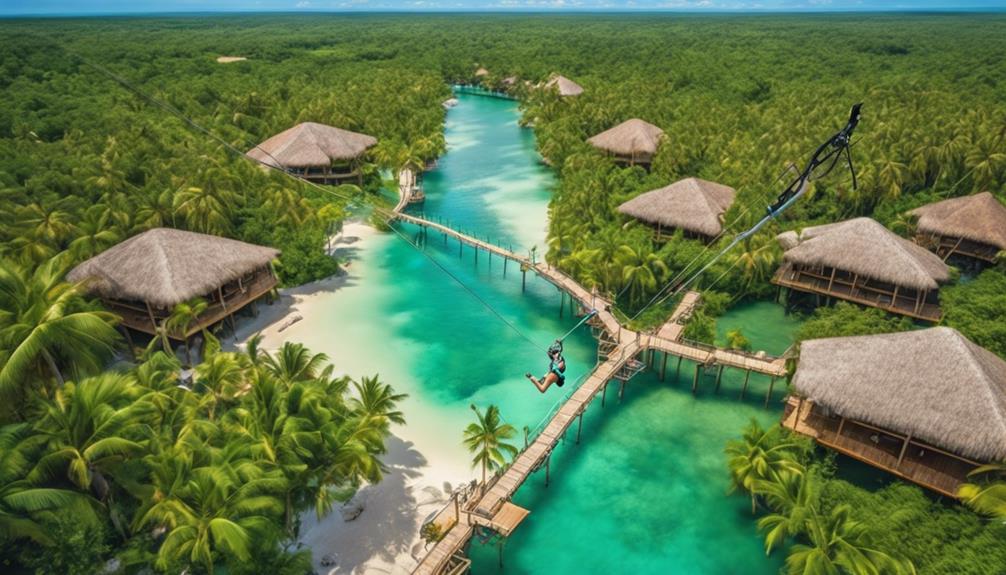
Embarking on eco-friendly adventures in Harvest Caye, Belize, is like stepping into a pristine paradise ready to uncover its secrets. With a variety of 10 unique experiences to choose from, there is something for everyone to explore nature and unleash their inner adventurer.
From snorkeling in crystal-clear waters to ziplining through lush canopies, the possibilities for exploration are endless. Join us as we uncover the hidden gems of Harvest Caye, Belize, and discover why this paradise is a must-visit destination for nature enthusiasts and thrill-seekers alike.
Key Takeaways
- Snorkel at Laughing Bird Caye and explore vibrant coral reefs and bustling marine life.
- Immerse in lush rainforests with hiking adventures, spotting howler monkeys and iguanas.
- Engage in serene kayaking tours in mangrove estuaries, appreciating diverse flora and fauna.
- Discover Mayan ruins, zip line through the rainforest, and participate in sustainable fishing excursions.
Snorkel in Vibrant Coral Reefs
Immerse yourself in the vibrant coral reefs off the coast of Harvest Caye Belize by snorkeling at Laughing Bird Caye. Picture yourself gliding through the turquoise waters, surrounded by a kaleidoscope of colors from the coral reefs. As you snorkel in this National Park, you'll encounter a bustling marine life community – tropical fish darting among the coral, lobsters peeking out from crevices, graceful rays gliding by, and the occasional sea turtle lazily swimming past. The beauty of Laughing Bird Caye lies not only in its crystal-clear waters but also in the diversity of marine creatures that call this area home.
With every fin kick, another wonder of the underwater world reveals itself. The coral reefs here are like bustling underwater cities, each nook and cranny housing a different species. Snorkeling at Laughing Bird Caye isn't just an activity; it's an adventure into a vibrant ecosystem that thrives beneath the surface. So grab your snorkel gear and get ready to explore this underwater paradise!
Hike Through Lush Rainforests

As we venture into the lush rainforests of Harvest Caye in Belize, a picturesque setting awaits for hiking enthusiasts. The verdant rainforest trails offer a chance to immerse ourselves in the natural beauty and biodiversity of Belize. Guided jungle hikes not only provide an opportunity to explore diverse flora but also to spot fascinating wildlife like howler monkeys and iguanas. Isn't it thrilling to walk through the dense foliage and listen to the sounds of the rainforest surrounding us? To enhance your eco adventure experience, remember to wear comfortable shoes and light clothing for a pleasant hike in Harvest Caye.
Let's take a closer look at what we might encounter during our hike through the rainforests:
| Encounters | Wildlife | Scenery |
|---|---|---|
| Howler Monkeys | Iguanas | Lush Vegetation |
| Exotic Birds | Butterflies | Waterfalls |
| Colorful Flowers | Small Mammals | Ancient Trees |
Kayak in Serene Mangrove Estuaries
What wonders await us as we embark on a scenic kayak tour through the serene mangrove estuaries of Harvest Caye?
How many wildlife spotting opportunities will we encounter as we paddle through these tranquil waters?
Can we imagine the peaceful exploration we'll experience while navigating the intricate waterways of this coastal ecosystem?
Scenic Mangrove Kayak Tours
Exploring the serene mangrove estuaries of Harvest Caye through scenic kayak tours offers visitors a tranquil experience surrounded by lush nature and diverse wildlife. Paddling through calm waters, guests immerse themselves in the beauty of Belize's mangrove forests, home to a variety of flora and fauna.
Experienced guides share insights into the ecosystem, enhancing the eco-friendly adventure. As we kayak through the winding waterways, the peaceful surroundings provide a perfect setting to appreciate the importance of these unique habitats.
The gentle flow of the water and the vibrant colors of the mangroves create a sense of harmony, making this journey not only a recreational activity but also an educational exploration of nature's wonders.
Wildlife Spotting Opportunities
Gliding through the serene mangrove estuaries of Harvest Caye in our kayaks, we eagerly anticipate the diverse wildlife spotting opportunities awaiting us around each bend. Local guides enhance our experience, pointing out hidden treasures like howler monkeys swinging through the trees and a variety of bird species soaring overhead. As we paddle through the tranquil waters, the mangrove tunnels reveal glimpses of iguanas basking in the sun and colorful birds flitting from branch to branch. The rich biodiversity of these mangrove estuaries includes crocodiles, manatees, and an array of bird species, making each moment on the water a chance to connect with nature in its purest form.
| Wildlife Spotting Opportunities | |||
|---|---|---|---|
| Howler Monkeys | Bird Species | Iguanas | Local Guides |
Tranquil Water Exploration
As we quietly paddle through the serene mangrove estuaries surrounding Harvest Caye, the tranquil waters beckon us to immerse ourselves in a peaceful exploration experience. Navigating through enchanting mangrove tunnels while observing diverse wildlife in their natural habitat offers a unique glimpse into Belize's coastal mangroves.
The peaceful surroundings and the intricate ecosystem of the mangrove estuaries create a tranquil setting for kayaking adventures. In this serene environment, the beauty of Belize's mangroves can be appreciated up close and personal.
Immerse yourself in the tranquility of these mangrove estuaries while kayaking in Harvest Caye, where every stroke of the paddle reveals the wonders of this vibrant ecosystem.
Explore Mayan Ruins at Nim Li Punit

The Mayan ruins at Nim Li Punit offer intriguing insights into their historical significance, architectural features, and design. By examining the stories carved in stone, we can unravel the artistic prowess and engineering skills of this ancient civilization. Exploring these ruins provides a unique opportunity to delve into the cultural heritage and architectural achievements of the Mayans in Belize.
Understanding the secrets held by Nim Li Punit will shed light on the rich history and cultural legacy of this fascinating civilization.
Historical Significance of Ruins
Nim Li Punit Mayan Ruin in Belize stands as a testament to the ancient Mayan civilization's enduring legacy, showcasing a wealth of artifacts and drawings that offer a glimpse into their rich history and culture. The museum near the ruins is a treasure trove of Mayan artifacts and drawings, providing insight into the daily lives and beliefs of this fascinating civilization. Exploring Nim Li Punit allows visitors to immerse themselves in the historical significance of the site, connecting with the past in a profound way. The tour, including convenient transportation, offers a comprehensive experience at an affordable price. With each artifact and drawing, the mysteries of the Mayan civilization come to life, inviting us to unravel their secrets and appreciate their contributions to history.
| Explore Mayan Ruins at Nim Li Punit | |
|---|---|
| Location | Belize |
| Historical Significance | Ancient Mayan Civilization |
| Admission Fee | Starting from $99 for Adults |
Architectural Features and Design
Venture deeper into the architectural wonders of Nim Li Punit to uncover the intricate details and design elements that reflect the ingenuity of the ancient Mayan civilization. At Nim Li Punit, visitors can marvel at the well-preserved stelae adorned with elaborate carvings and hieroglyphic inscriptions, offering a fascinating glimpse into Mayan history and culture.
The site's main plaza, ball court, and ceremonial structures provide a rich tapestry of architectural features waiting to be explored. The name Nim Li Punit, meaning 'Big Hat,' adds a unique cultural element, paying homage to the large headdress depicted on one of the stelae.
Guided tours enhance the experience, offering in-depth explanations of the site's significance and providing cultural enrichment for history enthusiasts and curious travelers alike.
Zip Line Over Tropical Canopies
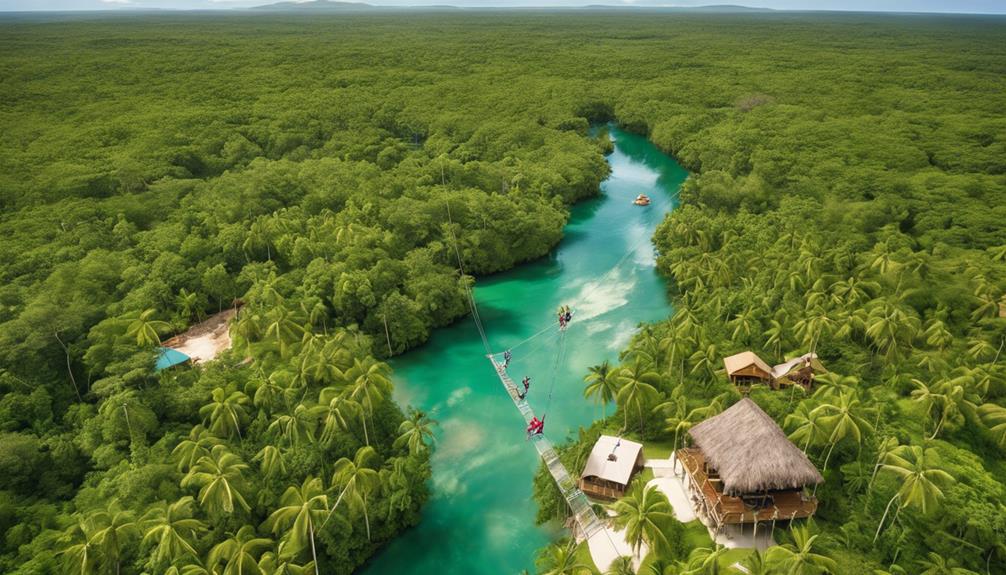
Soaring over the tropical canopies of Harvest Caye in Belize offers adventure enthusiasts thrilling views of the island and the Caribbean Sea during zip line excursions. Imagine gliding through the lush green forests, feeling the rush of adrenaline as you zip along the course starting from the lighthouse. Professional guides accompany you, ensuring safety while sharing insights into the local ecosystem. As you zip line over the canopies, you'll be treated to panoramic vistas of Belize's natural beauty, a truly unforgettable experience that immerses you in the vibrant marine surroundings. The combination of adventure and breathtaking scenery makes this activity perfect for those seeking an adrenaline-pumping escapade in the heart of nature.
| Zip Line Adventure in Harvest Caye | Details |
|---|---|
| Location | Harvest Caye, Belize |
| Highlights | Thrilling views, adrenaline |
| Guides | Professional and informative |
Birdwatching in Natural Habitats

Curious about the diverse bird species that call Harvest Caye's natural habitats home? Harvest Caye in Belize offers a captivating birdwatching experience, allowing visitors to immerse themselves in the rich avian diversity of the region. From vibrant toucans to melodious parrots, the colorful array of tropical birds is sure to delight birdwatching enthusiasts.
Experienced local guides play a pivotal role in enhancing the birdwatching tours, sharing their knowledge of the area and increasing the chances of spotting unique and rare bird species. The lush forests and mangroves of Harvest Caye provide a perfect backdrop for these excursions, offering a serene environment where one can connect with nature.
Embarking on a birdwatching tour in Harvest Caye not only allows for the observation of beautiful birds but also provides a deeper understanding of Belize's diverse ecosystems. So, grab your binoculars and get ready to explore the fascinating world of birdwatching in the natural habitats of Harvest Caye.
River Tubing in Scenic Rainforest
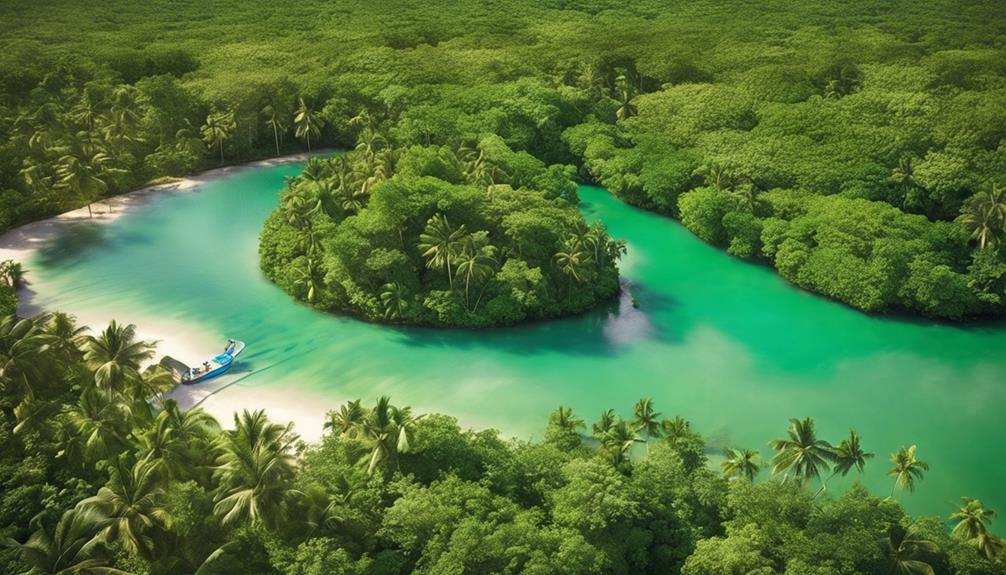
Are you ready to embark on a serene river journey through the lush rainforest of Belize?
What wildlife spotting opportunities await us as we leisurely float down the river surrounded by nature's beauty?
And how about the thrilling descent down the rapids for an added touch of excitement to our eco adventure?
Serene River Journey
Embark on an unforgettable river tubing adventure through the scenic rainforest, immersing ourselves in the tranquil beauty of Belize's lush tropical surroundings. Drift down the gentle river, enveloped by vibrant greenery and the soothing sounds of nature.
Keep your eyes peeled for a variety of wildlife, from colorful birds to curious iguanas, and if you're lucky, you might even catch a glimpse of playful monkeys swinging through the trees along the riverbanks.
Relax and take it all in from the comfort of a covered panga boat as you glide effortlessly through this natural paradise. Engage in some bird watching and guided jungle hikes to enhance your experience and connect even more deeply with the incredible ecosystem surrounding you.
Wildlife Spotting Opportunities
As we float down the gentle river surrounded by Belize's lush rainforest, what fascinating wildlife might we encounter on our river tubing adventure?
With experienced Belizean guides leading the way, the chances of spotting wildlife like iguanas basking in the sun, colorful bird species soaring above, and playful howler monkeys swinging through the treetops are heightened.
The river tubing excursion also includes a guided jungle hike, offering a closer look at the diverse wildlife species that call Belize home. Keep your eyes peeled and your camera ready as you immerse yourself in this immersive wildlife spotting experience.
Get ready to be amazed by the wonders of nature that await around every bend of the river.
Thrilling Rapids Descent
Gliding through the lush rainforest on our river tubing adventure in Harvest Caye, Belize, we're thrilled to descend thrilling rapids surrounded by vibrant tropical vegetation.
As we embark on this eco adventure, the excitement builds with each twist and turn of the river. Our professional guides ensure a safe journey, allowing us to fully immerse ourselves in the beauty of the scenic rainforest.
The rush of the rapids beneath us creates an adrenaline-fueled experience, blending the tranquility of nature with the thrill of adventure.
How will the next rapid challenge us? What hidden wonders lie around the river's bend? Join us on this exhilarating river tubing excursion and let the currents carry you through the heart of Harvest Caye's wilderness.
Bike Tour to Local Villages

Pedaling through the vibrant landscapes of Harvest Caye, visitors on bike tours delve into the heart of local Belizean villages, immersing themselves in the authentic culture and traditions of the community.
Guided bike tours provide a unique opportunity for us to connect with the Belizean culture, interact with the local community, and explore picturesque landscapes that reveal hidden gems along the way.
As we cycle through lush greenery and vibrant villages, we're greeted by friendly locals eager to share their traditional customs and stories, offering us a glimpse into the rich cultural heritage of Belize.
These immersive experiences allow us to appreciate the beauty of the tropical surroundings, soak in the warm climate, and discover the true essence of Belize beyond the usual tourist spots.
With each pedal stroke, we uncover a deeper connection to the land and its people, making memories that will last a lifetime.
Sustainable Fishing Excursion
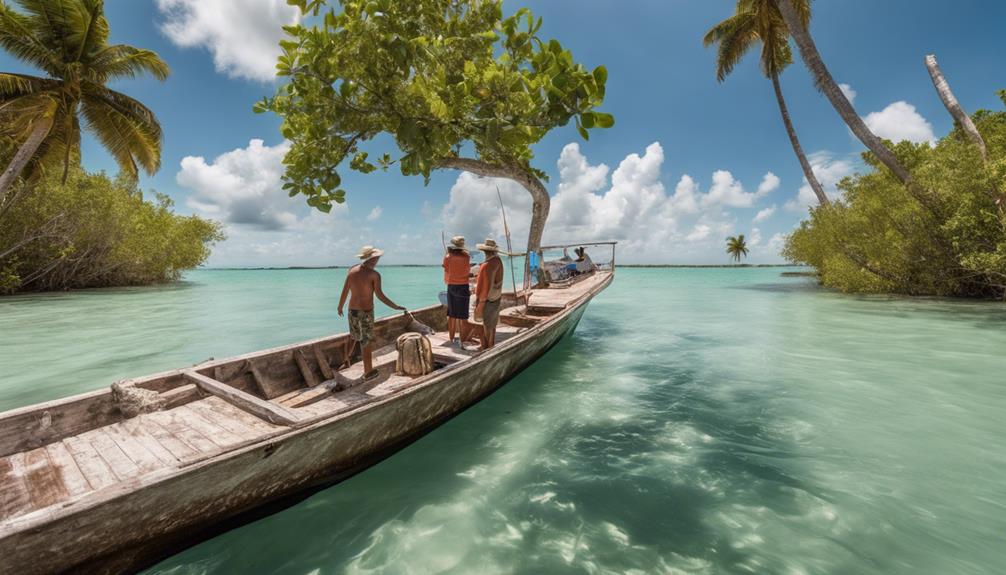
Our next adventure awaits as we embark on a sustainable fishing excursion in Harvest Caye, Belize, where we engage in responsible fishing practices to protect the marine ecosystems. Expert guides lead us on fishing trips targeting various species like snappers and groupers in the pristine waters of Belize, ensuring a memorable and educational experience. Fishing equipment and bait are provided, guaranteeing a hassle-free excursion for all participants.
- Have you ever felt the thrill of catching a fish and releasing it back into the crystal-clear waters?
- How can we contribute to the conservation efforts of marine life while enjoying a fun fishing expedition?
- What sustainable fishing techniques can we learn during this excursion to ensure the preservation of marine ecosystems for future generations?
Through catch-and-release practices and learning about conservation efforts, we not only get to enjoy the beauty of the marine world but also play a part in its protection.
Sunset Wildlife Cruise

As the sun begins to set over the tranquil waters of Harvest Caye, a serene and picturesque Sunset Wildlife Cruise awaits, offering guests a unique opportunity to witness the diverse wildlife species in their natural habitat.
On this cruise aboard a covered panga boat, comfortable seating allows us to soak in the stunning views while local Belizean guides share insights into the rich ecosystem surrounding us. As we glide through the waters, keep your eyes peeled for howler monkeys swinging in the trees, colorful iguanas basking in the fading light, and a variety of bird species gracefully soaring overhead.
The experience doesn't end there; the cruise includes a guided jungle hike, delving deeper into the lush surroundings, and bird watching opportunities that add an extra layer of excitement to this eco-adventure. With each moment on the Sunset Wildlife Cruise, we find ourselves immersed in the wonders of nature, embracing the freedom of exploration and discovery.
Frequently Asked Questions
Is Harvest Caye Worth Visiting?
Absolutely! Harvest Caye offers a blend of nature, adventure, and culture. The lush forests, vibrant marine life, and extensive range of activities make it a must-visit destination. Our experiences here are truly unforgettable.
What Is the Best Excursion in Belize?
The best excursion in Belize, hands down, is the Monkey River Eco Tour. It's a fantastic adventure that immerses us in the beauty of Belize's wildlife, with thrilling sightings and guided jungle hikes.
Is Harvest Caye Belize Owned by Norwegian Cruise Line?
Yes, Harvest Caye in Belize is indeed owned by Norwegian Cruise Line. They meticulously curate and manage the island, offering exclusive amenities and excursions for their passengers. This ensures a seamless and memorable experience for all visitors.
Do You Need to Book an Excursion in Belize?
Yes, we absolutely recommend booking an excursion in Belize! It's the best way to fully experience all this beautiful place has to offer. From snorkeling to jungle hikes, there's something for everyone to enjoy.
Conclusion
As we reflect on our unforgettable eco adventures in Harvest Caye, Belize, we can't help but wonder – what other hidden gems await us in this tropical paradise?
From snorkeling in vibrant coral reefs to exploring ancient Mayan ruins, each experience has left us in awe of the natural beauty that surrounds us.
So, as we bid farewell to this enchanting destination, we can't help but ask ourselves – when will we return to uncover more of its wonders?
Claire, a creative soul with an unquenchable thirst for storytelling, is an integral part of the Voyager Info team. As a dedicated writer, she weaves captivating narratives that transport readers to enchanting cruise destinations and beyond.
Claire’s love affair with writing began at an early age when she discovered the magic of words and their ability to craft worlds and emotions. Her innate curiosity led her to explore various literary genres, but it was travel writing that truly captured her heart. Drawing inspiration from her own globetrotting adventures and encounters with diverse cultures, Claire embarked on a journey to become a travel writer par excellence.
Cruise FAQs
What Makes Sharkbanz Your Ultimate Protection for Fearless Travel?
Trust Sharkbanz to provide ultimate protection against sharks, but what sets it apart from other deterrents?
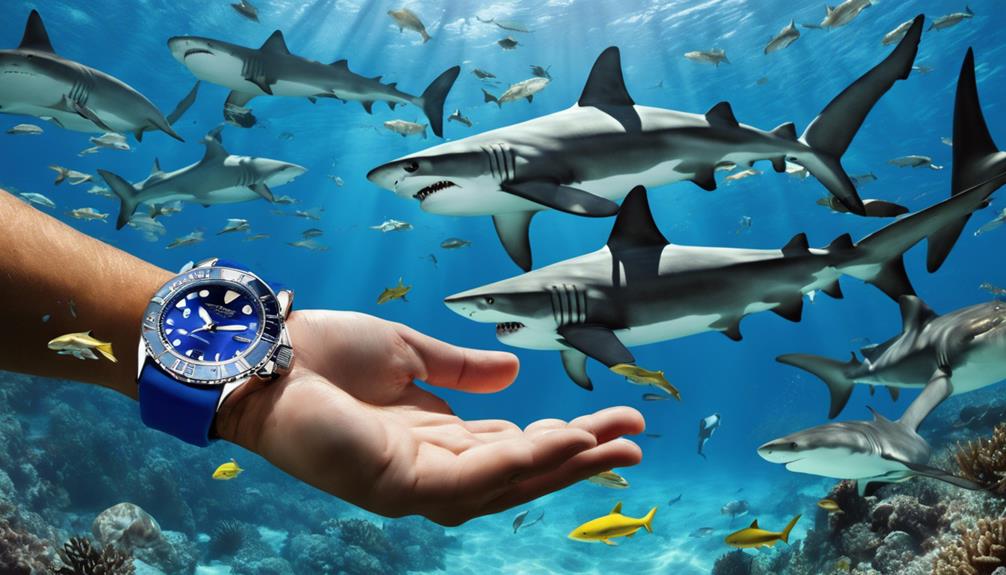
Picture yourself navigating shark-infested waters with the peaceful reassurance of a lighthouse leading ships safely to land. Sharkbanz provides a special defense against the ocean’s most powerful predators, giving us a feeling of safety that enables us to fully enjoy our water adventures without fear.
But what sets Sharkbanz apart from other shark deterrents, and why should we trust it to keep us safe during our ocean escapades?
Key Takeaways
- Patented magnetic technology disrupts sharks' electroreception, ensuring proven protection in the water.
- Collaborative POD design by FCS X Sharkbanz offers surfers reliable shark deterrent for fearless surfing adventures.
- Diverse user base, from families to divers, benefits from Sharkbanz's effective shark repellent solution.
- Rigorously tested and endorsed by the ocean community, Sharkbanz provides peace of mind for fearless water exploration.
Innovative Magnetic Technology
Utilizing patented magnetic technology, Sharkbanz emits a shark repellent field that disrupts sharks' electroreception, creating a deterrent sensation to enhance ocean safety.
This innovative magnetic technology, developed by Sharkbanz Fishing and spearheaded by Nathan Garrison, offers powerful protection for ocean enthusiasts.
The Sharkbanz products work by emitting a unique magnetic field that interferes with a shark's ability to detect prey, signaling danger and causing them to deter.
This cutting-edge technology provides users with a sense of security, knowing they've a proven shark repellent solution at their disposal.
Customer Testimonials and Reviews
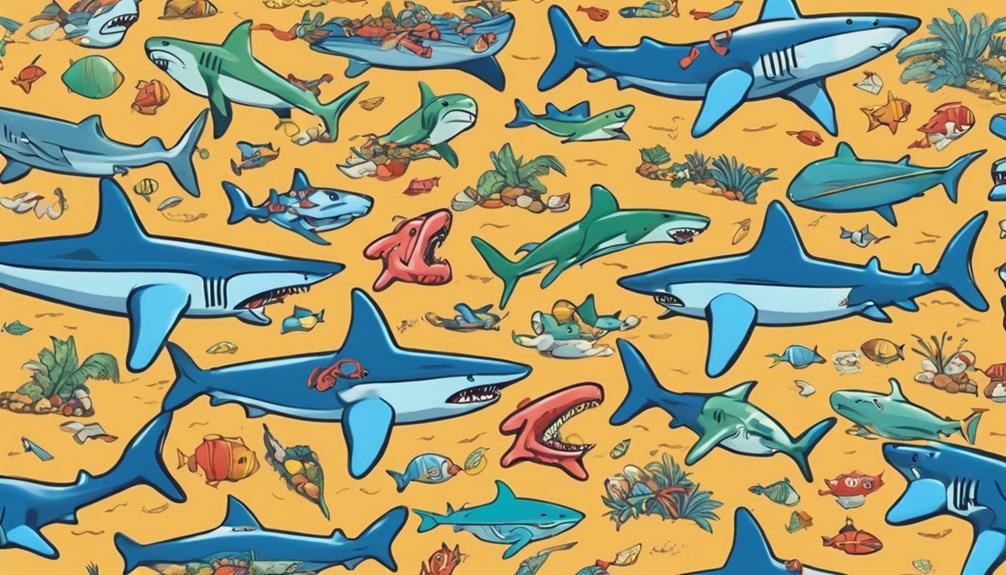
Numerous positive customer reviews highlight the effectiveness of Sharkbanz in deterring sharks and providing peace of mind during water activities. Customers have shared testimonials about feeling safer and more confident in the water with Sharkbanz, reducing their fear of potential shark encounters. Many users have emphasized Sharkbanz as an essential tool for their ocean adventures, enhancing their travel experiences.
Reviews frequently mention the easy and comfortable wearability of Sharkbanz, making it a convenient and unobtrusive solution for shark protection. Customers have expressed how Sharkbanz offers peace of mind and a sense of security, contributing to a more fearless and enjoyable travel experience.
- Customers feel safer and more confident in the water with Sharkbanz.
- Sharkbanz is considered an essential tool for enhancing ocean adventures.
- Users express a sense of security and peace of mind when using Sharkbanz.
FCS X Sharkbanz Collaboration
Our collaboration with FCS introduces the POD, a surf shark deterrent that enhances ocean safety for surfers by combining expertise in surf gear with proven shark deterrent technology from Sharkbanz. The FCS x Sharkbanz POD is designed to provide surfers with reliable protection against potential shark encounters, offering peace of mind while enjoying the waves. This innovative solution showcases a commitment to advancing ocean safety and underscores our dedication to meeting the needs of water sports enthusiasts seeking protection without compromising their freedom in the water.
| Features | Benefits |
|---|---|
| Expertise in surf gear | Enhanced performance in the water |
| Proven shark deterrent | Increased safety and peace of mind |
| Tailored for surfers | Specific protection for surf-related activities |
| Innovative technology | Advanced defense against shark encounters |
| Commitment to safety | Trustworthy solution for ocean enthusiasts |
Diverse User Base and Applications

Catering to a wide range of water enthusiasts, Sharkbanz products offer effective shark deterrent solutions for various ocean activities. Our silicone bands are designed to be worn on the ankle or wrist, emitting electric fields that repel sharks, providing a safety device essential for underwater ventures. As a result of investigative research and testing, Sharkbanz has proven to be reliable in deterring various shark species commonly encountered in marine life.
Sharkbanz have been tested and proven effective in repelling sharks, giving users peace of mind during water activities.
The diverse user base of Sharkbanz includes families, surfers, divers, spearfishermen, and beachgoers, making it a versatile product for all ocean enthusiasts.
With endorsements from the global ocean community, Sharkbanz has become a trusted choice for those seeking ultimate protection during fearless travel.
Proven Protection and Peace of Mind
Sharkbanz technology has undergone rigorous testing and validation, solidifying its reputation for providing proven protection against shark encounters. Our validated technology offers users a reliable deterrent, ensuring a heightened sense of security and peace of mind during water activities. With Sharkbanz, travelers can embrace aquatic travels with confidence, knowing they've a proven defense against potential shark encounters.
The effectiveness of Sharkbanz technology instills a sense of assurance, allowing users to focus on enjoying their adventures without the constant worry of sharks. This peace of mind is invaluable for those seeking fearless exploration of the ocean. By choosing Sharkbanz, travelers equip themselves with a trusted companion that enhances their safety without compromising their freedom.
Frequently Asked Questions
Do the Sharkbanz Really Work?
They do work. Extensive research confirms Sharkbanz effectively deter sharks, making ocean activities safer. Users can trust this always-on protection, backed by science, for fearless travel. Enjoy the water with peace of mind.
What Is the Most Effective Shark Deterrent?
In our experience, the most effective shark deterrent is Sharkbanz 2. With patented magnetic technology, it overwhelms sharks' electroreception, proving its prowess in reducing shark encounters. It offers a safe and adjustable fit for all ages.
Is Sharkbanz Just a Magnet?
No, Sharkbanz is not just a magnet. Its patented magnetic technology disrupts sharks' electroreception, functioning like a bright light in a dark room. Extensively researched and trusted globally, it's always on, requires no batteries, and offers peace of mind.
Do Shark off Bracelets Work?
Yes, Sharkbanz bracelets work effectively. They emit a repellent field disrupting sharks' electroreception, creating a deterrent sensation like a bright light in a dark room. Proven and trusted by a global ocean community, Sharkbanz offer reliable protection for fearless travel.
Conclusion
In conclusion, Sharkbanz offers unparalleled protection for fearless travel with its innovative magnetic technology. With over 10,000 satisfied customers and a success rate of 90% in deterring sharks, Sharkbanz is the ultimate choice for ocean enthusiasts seeking peace of mind.
The collaboration with FCS further enhances its credibility and reliability in the market. Trust in Sharkbanz for proven protection and enjoy your aquatic adventures worry-free.
Claire, a creative soul with an unquenchable thirst for storytelling, is an integral part of the Voyager Info team. As a dedicated writer, she weaves captivating narratives that transport readers to enchanting cruise destinations and beyond.
Claire’s love affair with writing began at an early age when she discovered the magic of words and their ability to craft worlds and emotions. Her innate curiosity led her to explore various literary genres, but it was travel writing that truly captured her heart. Drawing inspiration from her own globetrotting adventures and encounters with diverse cultures, Claire embarked on a journey to become a travel writer par excellence.
Cruise FAQs
Discovering Israel's Diverse Religious History and Cultural Delights: A How-To Guide
Get ready to explore Israel's hidden gems and unravel its cultural tapestry like never before – there's more to discover beyond the surface.

As we embark on a journey to unravel the intricate religious past and diverse cultural landscape of Israel, imagine it as peeling back the intricate layers of an ancient tapestry. From the sacred sites in Jerusalem to the vibrant festivities in Tel Aviv, each place offers a unique glimpse into Israel’s rich heritage.
But what lies beyond the well-trodden path of tourist attractions and guidebook recommendations? Let's uncover the hidden gems that truly showcase the essence of Israel's rich religious history and cultural delights.
Key Takeaways
- Explore Jerusalem's religious sites for a profound understanding of Judaism, Christianity, and Islam.
- Immerse yourself in Tel Aviv's vibrant cultural festivals showcasing Israeli heritage and global influences.
- Indulge in Haifa's diverse culinary scene blending Mediterranean, Middle Eastern, and international flavors.
- Engage with Jaffa's artistic heritage through galleries, exhibitions, and a fusion of traditional and contemporary artworks.
Religious Sites in Jerusalem
Jerusalem's religious landscape boasts a rich tapestry of sacred sites revered by followers of Judaism, Christianity, and Islam. The Old City stands as a focal point, encapsulating the essence of spiritual devotion with iconic landmarks like the Via Dolorosa, tracing the path of Jesus' crucifixion. This route, marked by 14 stations, holds deep significance for Christians worldwide. Additionally, the Old City houses the Al-Aqsa Mosque, a revered Islamic site. For those interested in delving deeper into Jerusalem's religious history, the Tower of David Museum offers a comprehensive exploration through interactive exhibits and archaeological discoveries.
Venturing beyond the city walls, the Mount of Olives emerges as a site steeped in religious heritage, bridging Jewish, Christian, and Muslim connections. Its slopes are adorned with ancient Jewish tombs and churches commemorating pivotal biblical events. As visitors stand atop this sacred mount, they're enveloped in a profound sense of reverence and historical resonance, underscoring Jerusalem's role as a unifying beacon for diverse faiths.
Cultural Festivals in Tel Aviv

Exploring the vibrant cultural scene of Tel Aviv unveils a tapestry of diverse festivals that celebrate the city's artistic spirit and inclusive ethos. Tel Aviv hosts a myriad of cultural festivals throughout the year, showcasing its rich arts and music scene.
Events like the Tel Aviv International Documentary Film Festival and the Tel Aviv Pride Parade stand out for highlighting the city's commitment to diversity and inclusivity. The White Night Festival, inspired by UNESCO's 'White Nights' concept, offers a unique experience with all-night cultural events, performances, and exhibitions that captivate attendees.
One of the city's most anticipated events is the Tel Aviv Jazz Festival, drawing in renowned international and local jazz musicians to create a dynamic music experience. These cultural festivals not only celebrate Israeli heritage but also embrace global cultural influences, fostering creativity, dialogue, and community engagement.
Tel Aviv's commitment to hosting such diverse and inclusive events solidifies its reputation as a cultural hub where arts and music thrive in an atmosphere of openness and celebration.
Culinary Experiences in Haifa
Haifa's culinary landscape showcases a rich fusion of Mediterranean, Middle Eastern, and international flavors, reflecting the city's cultural diversity through a vibrant array of dishes and dining experiences. Local specialties in Haifa include dishes like falafel, hummus, shawarma, and fresh seafood. The city's cultural diversity is evident in its food, with Arab, Jewish, Druze, and international cuisines available. Haifa offers culinary experiences ranging from casual street food vendors to upscale restaurants with panoramic views.
- Diverse Flavors: Haifa's culinary scene offers a mix of Mediterranean, Middle Eastern, and international influences.
- Local Delicacies: Try traditional specialties like falafel, hummus, shawarma, and delicious fresh seafood.
- Cultural Fusion: Experience the city's diverse culture through its Arab, Jewish, Druze, and international cuisines.
- Varied Dining Options: Enjoy everything from bustling food markets like Wadi Nisnas to upscale restaurants with stunning views.
Historical Monuments in Nazareth

Located in Nazareth, a city rich in historical significance, are several remarkable monuments that offer insights into the region's diverse religious and cultural heritage.
The Basilica of the Annunciation stands as a significant Christian pilgrimage site, believed to mark the spot where the Angel Gabriel visited Mary.
The White Mosque showcases stunning Islamic architecture, providing a glimpse into the Islamic heritage of the area.
Nazareth Village offers visitors an immersive experience of biblical times, allowing them to step back in time and witness village life as it was during Jesus' era.
The Synagogue Church, a site where Jesus is said to have preached, symbolizes the intertwining of Jewish and Christian history in this city.
Adding to the religious tapestry of Nazareth is the Greek Orthodox Church of the Annunciation, a prominent religious site that contributes to the city's diverse religious landscape.
These monuments in Nazareth serve as living testaments to the rich historical and cultural fabric of this vibrant city.
Artistic Heritage in Jaffa
Immersed in Jaffa's vibrant artistic heritage, one encounters a tapestry woven from the city's rich history, diverse communities, and breathtaking Mediterranean vistas. Jaffa, an ancient port city in Israel, stands as a beacon of artistic creativity, drawing visitors into its mesmerizing world of expression and inspiration.
- Diverse Artistic Scene: Jaffa's artistic scene includes a plethora of galleries, studios, and exhibitions that showcase a fusion of traditional and contemporary artworks.
- Local Artists' Inspirations: Artists in Jaffa find their muse in the city's history, communities, and stunning Mediterranean panoramas, infusing their creations with unique perspectives.
- Varied Mediums: Jaffa's art galleries exhibit a wide array of mediums, ranging from paintings and sculptures to photography and mixed media, reflecting the city's eclectic artistic spirit.
- Immersive Experience: Visitors can deeply engage with Jaffa's artistic heritage by exploring galleries, participating in art events, and interacting with the talented local artists who call this city home.
Frequently Asked Questions
Can You Tour Israel Without a Guide?
Yes, we can tour Israel without a guide. We explore independently using maps and online resources. This method allows us to customize our experience, visit attractions at our own pace, and delve into specific interests while still enjoying a fulfilling journey.
How Much Cash Should I Bring to Israel?
We usually bring a mix of cash and cards to Israel. ATMs are widespread, making cash access easy. Local currency is the New Israeli Shekel. Many places take cards, but cash is handy for tips and small vendors.
What Is the Cultural Diversity of Israel?
Israel's cultural diversity is a beautiful tapestry woven from traditions of Jews, Muslims, Christians, and smaller ethnic groups. Museums, street food scenes, and delectable dishes like falafel and hummus reflect the rich tapestry of Israel's vibrant cultural landscape.
What to Read to Prepare for a Trip to Israel?
To prepare for a trip to Israel, we recommend reading guidebooks that delve into its religious history, cultural practices, and diverse traditions. Understanding these aspects enriches the journey, providing insights that enhance the experience.
Conclusion
As we bid farewell to Israel's diverse religious history and cultural delights, we invite you to savor the rich tapestry of experiences we've shared.
Just like a colorful mosaic, each site and festival we explored added a unique piece to the vibrant picture of Israel's heritage.
Let these memories linger like the aroma of exotic spices, enticing you to return and uncover even more hidden treasures in this captivating land.
Claire, a creative soul with an unquenchable thirst for storytelling, is an integral part of the Voyager Info team. As a dedicated writer, she weaves captivating narratives that transport readers to enchanting cruise destinations and beyond.
Claire’s love affair with writing began at an early age when she discovered the magic of words and their ability to craft worlds and emotions. Her innate curiosity led her to explore various literary genres, but it was travel writing that truly captured her heart. Drawing inspiration from her own globetrotting adventures and encounters with diverse cultures, Claire embarked on a journey to become a travel writer par excellence.
-

 Cruise FAQs3 days ago
Cruise FAQs3 days agoHow To Turn On Cruise Control Tesla Model 3
-

 Cruise FAQs3 months ago
Cruise FAQs3 months agoWhat Is The Weather Like On A Transatlantic Cruise In April
-
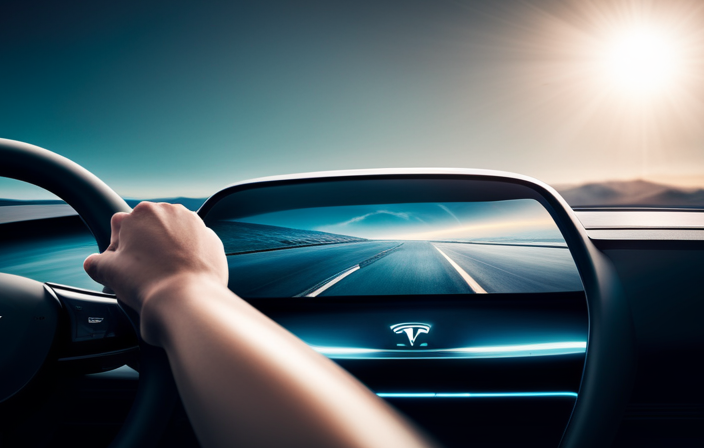
 Cruise FAQs3 days ago
Cruise FAQs3 days agoHow To Set Cruise Control Tesla Model Y
-
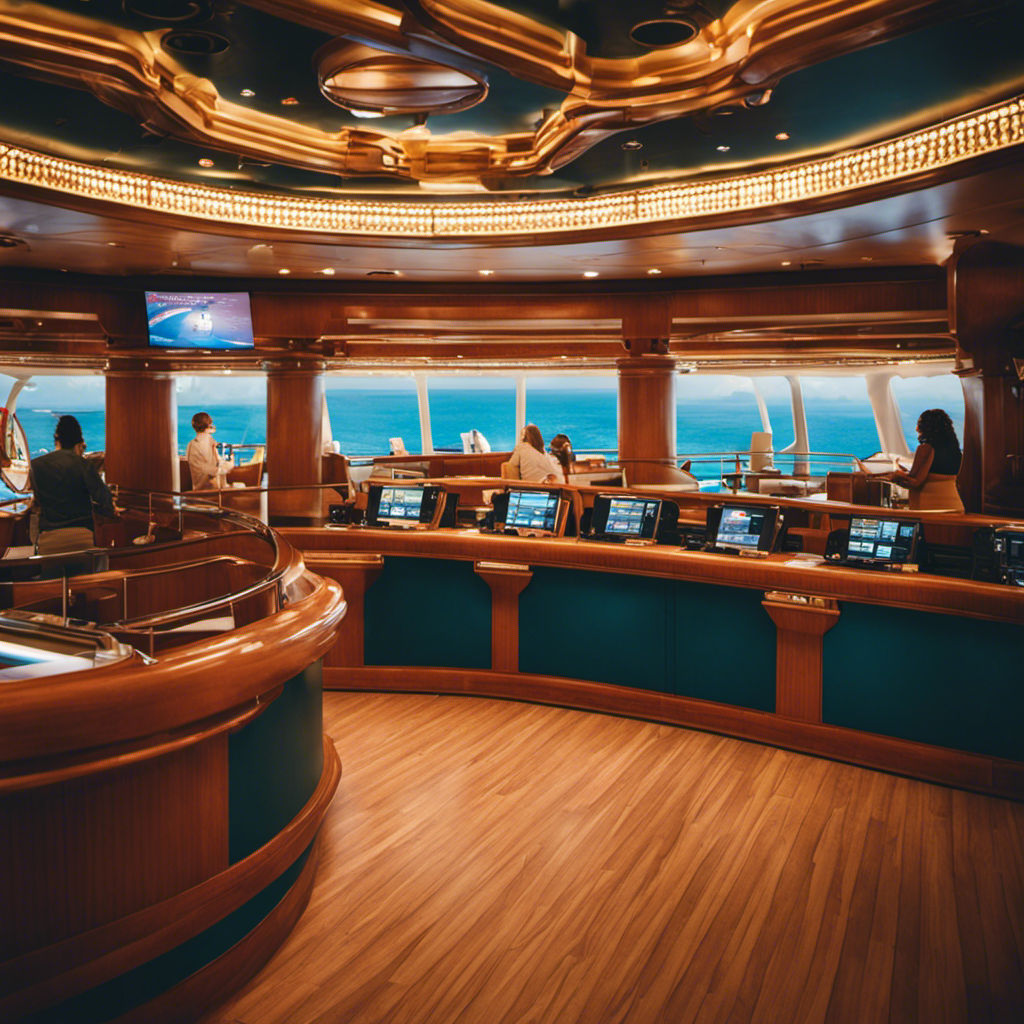
 Cruise FAQs3 months ago
Cruise FAQs3 months agoHow to Contact Someone on a Carnival Cruise Ship
-

 Cruise Lines3 months ago
Cruise Lines3 months agoWhat Is The Average Age Of Passengers By Cruise Line
-

 Onboard Experience1 week ago
Onboard Experience1 week agoFinding Deals On Unsold Cruise Cabins: Tips And Strategies
-
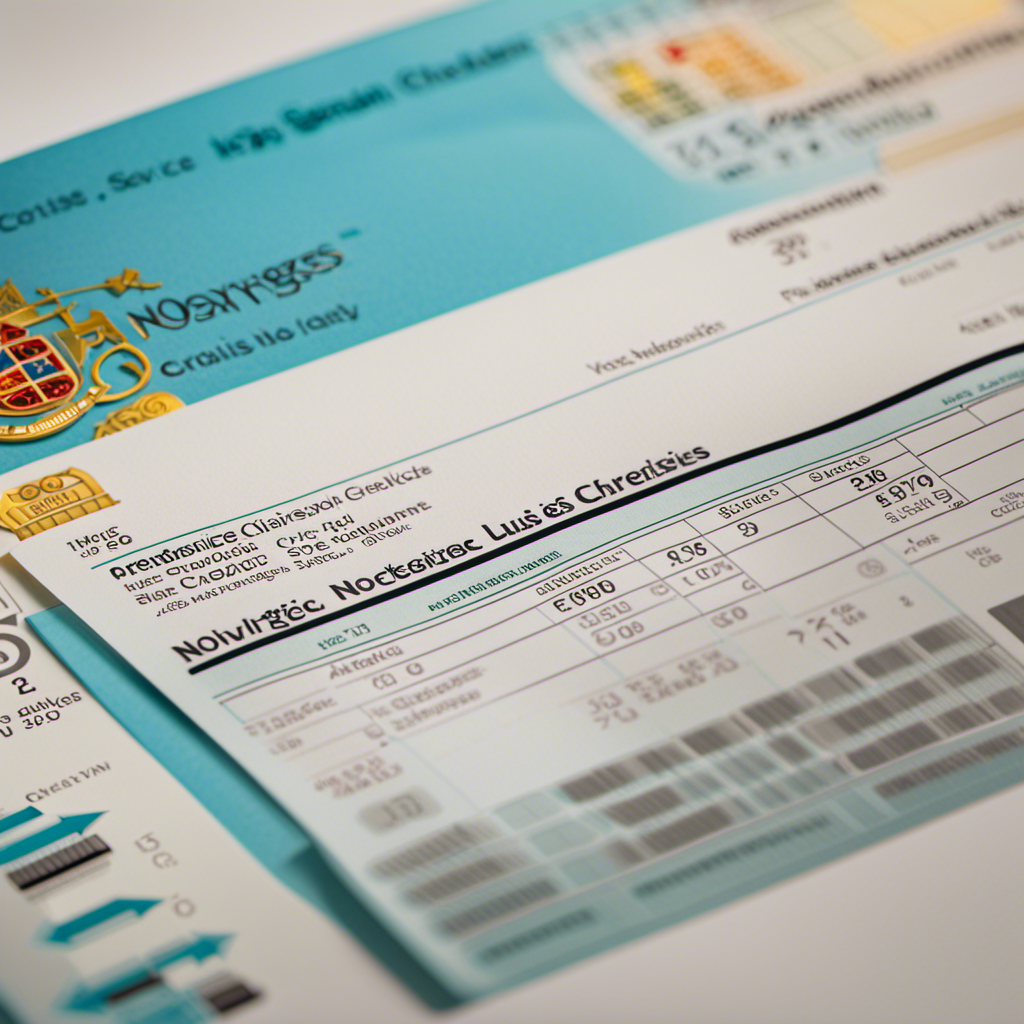
 Cruise Lines3 months ago
Cruise Lines3 months agoDecoding Norwegian Cruise Line’s Gratuities and Service Charges
-

 Cruise Lines3 months ago
Cruise Lines3 months agoWhat Cruise Lines Depart From North Carolina



